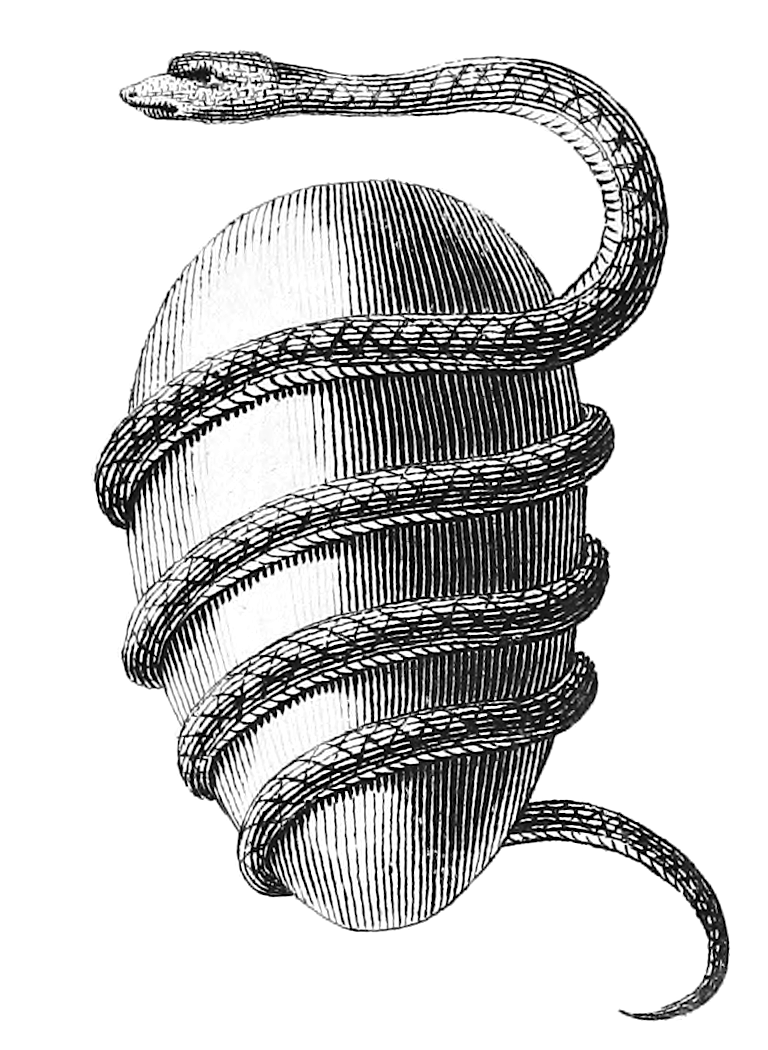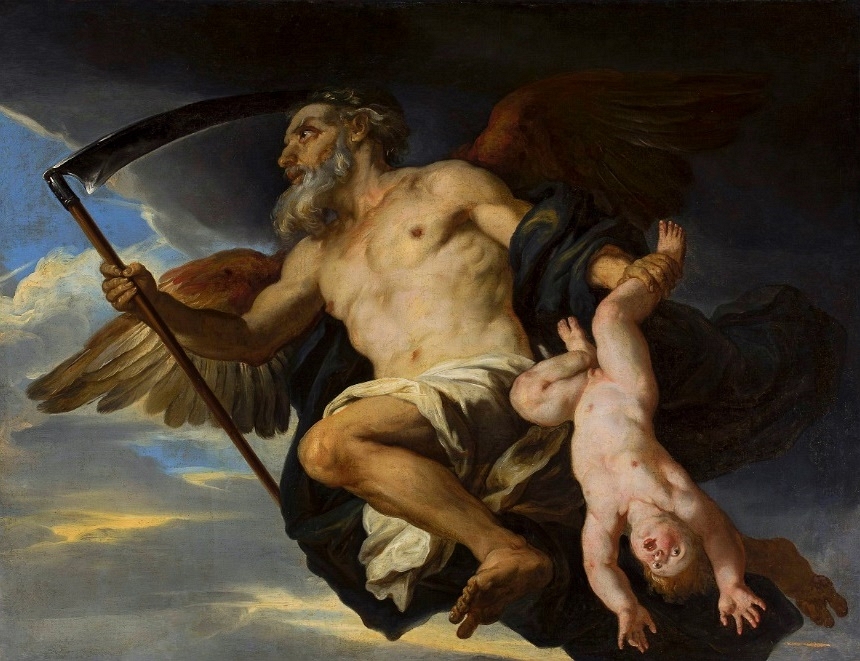|
Ananke
In ancient Greek religion, Ananke (; grc, Ἀνάγκη), from the common noun , "force, constraint, necessity") is the personification of inevitability, compulsion and necessity. She is customarily depicted as holding a spindle. One of the Greek primordial deities, the births of Ananke and her brother and consort, Chronos (the personification of Time, not to be confused with the Titan Cronus) were thought to mark the division between the eon of Chaos and the beginning of the cosmos. Ananke is considered the most powerful dictator of fate and circumstance. Mortals and gods alike respected her power and paid her homage. Sometimes considered the mother of the Fates, she is thought to be the only being to influence their decisions (according to some sources, excepting Zeus also). According to Schowalter and Friesen, she and the Fates "are all sufficiently tied to early Greek mythology to make their Greek origins likely." The ancient Greek traveller Pausanias wrote of a templ ... [...More Info...] [...Related Items...] OR: [Wikipedia] [Google] [Baidu] |
Necessitas
In ancient Greek religion, Ananke (; grc, Ἀνάγκη), from the common noun , "force, constraint, necessity") is the personification of inevitability, compulsion and necessity. She is customarily depicted as holding a spindle. One of the Greek primordial deities, the births of Ananke and her brother and consort, Chronos (the personification of Time, not to be confused with the Titan Cronus) were thought to mark the division between the eon of Chaos and the beginning of the cosmos. Ananke is considered the most powerful dictator of fate and circumstance. Mortals and gods alike respected her power and paid her homage. Sometimes considered the mother of the Fates, she is thought to be the only being to influence their decisions (according to some sources, excepting Zeus also). According to Schowalter and Friesen, she and the Fates "are all sufficiently tied to early Greek mythology to make their Greek origins likely." The ancient Greek traveller Pausanias wrote of a temple ... [...More Info...] [...Related Items...] OR: [Wikipedia] [Google] [Baidu] |
Moirai
In ancient Greek religion and mythology, the Moirai (, also spelled Moirae or Mœræ; grc, Μοῖραι, "lots, destinies, apportioners"), often known in English as the Fates ( la, Fata, Fata, -orum (n)=), were the personifications of fate; their Roman equivalent was the Parcae (euphemistically the "sparing ones"), and there are other equivalents in cultures that descend from the Proto-Indo-European culture. Their number became fixed at three: Clotho ("spinner"), Lachesis ("allotter") and Atropos ("the unturnable", a metaphor for death). However, according to the often cited Latin verse ''Clotho colum retinet, Lachesis net, et Atropos occat'', their roles and functions were also seen differently: Clotho, the youngest of the sisters, presided over the moment in which we are born, and held a distaff in her hand; Lachesis spun out all the events and actions of our life; and Atropos, the eldest of the three, cut the thread of human life with a pair of scissors. The role of th ... [...More Info...] [...Related Items...] OR: [Wikipedia] [Google] [Baidu] |
Phanes (mythology)
Phanes ( grc, Φάνης, Phánēs, genitive ) or Protogonus () was the mystic primeval deity of procreation and the generation of new life, who was introduced into Greek mythology by the Orphic tradition; other names for this Classical Greek Orphic concept included Ericapaeus ( grc, Ἠρικαπαῖος/Ἠρικεπαῖος, Ērikapaîos/Ērikepaîos, power) and Metis ("thought"). Mythology Orphic cosmogony In Orphic cosmogony, Phanes is often equated with Eros or Mithras, and has been depicted as a deity emerging from a cosmic egg, entwined with a serpent. He had a helmet and had broad, golden wings. The Orphic cosmogony is quite unlike the creation sagas offered by Homer and Hesiod. Scholars have suggested that Orphism is "un-Greek" even "Asiatic" in conception, because of its inherent dualism. Chronos (Time) is said to have created the silver egg of the universe, out of which burst the first-born deity Phanes, or Phanes-Dionysus. Phanes was a male God, in an o ... [...More Info...] [...Related Items...] OR: [Wikipedia] [Google] [Baidu] |
Aether (mythology)
In Greek mythology, Aether, Æther, Aither, or Ether (; grc, Αἰθήρ (Brightness) ) is the personification of the bright upper sky. According to Hesiod, he was the son of Erebus (Darkness) and Nyx (Night), and the brother of Hemera (Day). In Orphic cosmogony Aether was the offspring of Chronus (Time), and the brother of Chaos and Erebus. Genealogy According to Hesiod's ''Theogony'', which contained the "standard" Greek genealogy of the gods, Aether was the offspring of Erebus and Nyx, and the brother of Hemera. However, other early sources give other genealogies. According to one, the union of Erebus and Nyx resulted in Aether, Eros, and Metis (rather than Aether and Hemera), while according to another, Aether and Nyx were the parents of Eros (in Hesiod, the fourth god to come into existence after Chaos, Gaia (Earth), and Tartarus). Others tell us that Uranus (Sky) (in Hesiod, the son of Gaia) was Aether's son, and that "everything came from" Aether. In Orphic cosmogony A ... [...More Info...] [...Related Items...] OR: [Wikipedia] [Google] [Baidu] |
Chaos (cosmogony)
Chaos ( grc, χάος, kháos) is the mythological void state preceding the creation of the universe (the cosmos) in Greek creation myths. In Christian theology, the same term is used to refer to the gap or the abyss created by the separation of heaven and earth. Etymology Greek ''kháos'' () means 'emptiness, vast void, chasm, abyss', related to the verbs ''kháskō'' () and ''khaínō'' () 'gape, be wide open', from Proto-Indo-European ', cognate to Old English ''geanian'', 'to gape', whence English ''yawn''. It may also mean space, the expanse of air, the nether abyss or infinite darkness.Lidell-Scott, ''A Greek–English Lexiconchaos/ref> Pherecydes of Syros (fl. 6th century BC) interprets ''chaos'' as water, like something formless that can be differentiated. ''Chaoskampf'' The motif of ''Chaoskampf'' (; ) is ubiquitous in myth and legend, depicting a battle of a culture hero deity with a ''chaos monster'', often in the shape of a serpent or dragon. Parallel concepts ... [...More Info...] [...Related Items...] OR: [Wikipedia] [Google] [Baidu] |
Bia (mythology)
In Greek mythology, Bia (; Ancient Greek: Βία ; means "power, force, strength") is the personification of force. Family Bia was the daughter of the Titan (mythology), Titan Pallas (Titan), Pallas and Oceanid Styx (mythology), Styx, and sister of Nike (mythology), Nike, Kratos (mythology), Kratos, and Zelus. : From Pallas the giant and Styx [were born]: Scylla, Vis (Force) [Bia], Invidia (Jealousy) [Zelos], Potestas (Power) [Kratos], Victoria (Victory) [Nike].Hyginus, ''Fabulae'' Preface Mythology Bia and her siblings were constant companions of Zeus. They achieved this honour after supporting him in the Titanomachy, Titan War along with their mother. Bia is one of the characters named in the Greek tragedy ''Prometheus Bound'', attributed to Aeschylus, where Hephaestus is compelled by the gods to bind Prometheus after he was caught stealing fire and offering the gift to mortals. Although she appears alongside her brother Kratos, she does not speak. Titanomachy Alo ... [...More Info...] [...Related Items...] OR: [Wikipedia] [Google] [Baidu] |
Chronos
Chronos (; grc-gre, Χρόνος, , "time"), also spelled Khronos or Chronus, is a personification of time in pre-Socratic philosophy and later literature. Chronos is frequently confused with, or perhaps consciously identified with, the Titan Cronus in antiquity due to the similarity in names. The identification became more widespread during the Renaissance, giving rise to the iconography of Father Time wielding the harvesting scythe. Greco-Roman mosaics depicted Chronos as a man turning the zodiac wheel. He is comparable to the deity Aion as a symbol of cyclical time. He is usually portrayed as an old callous man with a thick grey beard, personifying the destructive and stifling aspects of time. Name During antiquity, Chronos was occasionally interpreted as Cronus. According to Plutarch, the Greeks believed that Cronus was an allegorical name for Chronos. Mythology In the Orphic tradition, the unaging Chronos was "engendered" by "earth and water", and produced Aether, ... [...More Info...] [...Related Items...] OR: [Wikipedia] [Google] [Baidu] |
Metaphysical Necessity
In philosophy, metaphysical necessity, sometimes called broad logical necessity, is one of many different kinds of necessity, which sits between logical necessity and nomological (or physical) necessity, in the sense that logical necessity entails metaphysical necessity, but not vice versa, and metaphysical necessity entails physical necessity, but not vice versa. A proposition is said to be ''necessary'' if it could not have failed to be the case. Nomological necessity is necessity according to the laws of physics and logical necessity is necessity according to the laws of logic, while metaphysical necessities are necessary in the sense that the world could not possibly have been otherwise. What facts are metaphysically necessary, and on what basis we might view certain facts as metaphysically but not logically necessary are subjects of substantial discussion in contemporary philosophy. The concept of a metaphysically necessary being plays an important role in certain arguments f ... [...More Info...] [...Related Items...] OR: [Wikipedia] [Google] [Baidu] |
Zeus
Zeus or , , ; grc, Δῐός, ''Diós'', label=Genitive case, genitive Aeolic Greek, Boeotian Aeolic and Doric Greek#Laconian, Laconian grc-dor, Δεύς, Deús ; grc, Δέος, ''Déos'', label=Genitive case, genitive el, Δίας, ''Días'' () is the sky father, sky and thunder god in ancient Greek religion, who rules as king of the gods on Mount Olympus. His name is cognate with the first element of his ancient Roman religion, Roman interpretatio graeca, equivalent Jupiter (mythology), Jupiter.''Larousse Desk Reference Encyclopedia'', The Book People, Haydock, 1995, p. 215. His mythology and powers are similar, though not identical, to those of Indo-European deities such as Jupiter, Perkūnas, Perun, Indra, Dyaus, and Zojz (deity), Zojz. Entry: "Dyaus" Zeus is the child of Cronus and Rhea (mythology), Rhea, the youngest of his siblings to be born, though sometimes reckoned the eldest as the others required disgorging from Cronus's stomach. In most traditions, he is m ... [...More Info...] [...Related Items...] OR: [Wikipedia] [Google] [Baidu] |
Pausanias (geographer)
Pausanias ( /pɔːˈseɪniəs/; grc-gre, Παυσανίας; c. 110 – c. 180) was a Greek traveler and geographer of the second century AD. He is famous for his ''Description of Greece'' (, ), a lengthy work that describes ancient Greece from his firsthand observations. ''Description of Greece'' provides crucial information for making links between classical literature and modern archaeology. Biography Not much is known about Pausanias apart from what historians can piece together from his own writing. However, it is mostly certain that he was born c. 110 AD into a Greek family and was probably a native of Lydia in Asia Minor. From c. 150 until his death in 180, Pausanias travelled through the mainland of Greece, writing about various monuments, sacred spaces, and significant geographical sites along the way. In writing ''Description of Greece'', Pausanias sought to put together a lasting written account of "all things Greek", or ''panta ta hellenika''. Living in t ... [...More Info...] [...Related Items...] OR: [Wikipedia] [Google] [Baidu] |
Corinth
Corinth ( ; el, Κόρινθος, Kórinthos, ) is the successor to an ancient city, and is a former municipality in Corinthia, Peloponnese, which is located in south-central Greece. Since the 2011 local government reform, it has been part of the municipality of Corinth, of which it is the seat and a municipal unit. It is the capital of Corinthia. It was founded as Nea Korinthos (), or New Corinth, in 1858 after an earthquake destroyed the existing settlement of Corinth, which had developed in and around the site of ancient Corinth. Geography Located about west of Athens, Corinth is surrounded by the coastal townlets of (clockwise) Lechaio, Isthmia, Kechries, and the inland townlets of Examilia and the archaeological site and village of ancient Corinth. Natural features around the city include the narrow coastal plain of Vocha, the Corinthian Gulf, the Isthmus of Corinth cut by its canal, the Saronic Gulf, the Oneia Mountains, and the monolithic rock of Acrocorinth ... [...More Info...] [...Related Items...] OR: [Wikipedia] [Google] [Baidu] |





